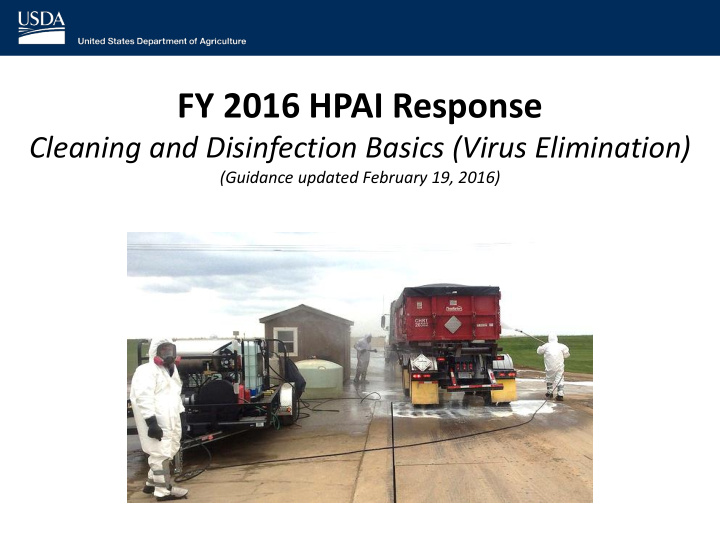



FY 2016 HPAI Response Cleaning and Disinfection Basics (Virus Elimination) (Guidance updated February 19, 2016) 1
Policy Update Provides responders with revised procedures learned from the 2014 – 2015 highly pathogenic avian influenza (HPAI) outbreak. Key Components General Guidance Definitions Options 2
General Guidance All previously HPAI Infected Premises must be both CLEANED and DISINFECTED. Cleaning and disinfection practices during an outbreak should focus on virus elimination in a cost- effective manner. While traditionally wet cleaning and disinfection has been performed in many incidents, dry cleaning and eliminating the virus through either heating of house or fumigation is a preferred approach during a widespread HPAI outbreak. Any method(s) selected should consider the characteristics of the premises/houses and other factors which may impact the effectiveness of the virus elimination activities. 3
Definitions Cleaning The removal of gross contamination, organic material, and debris from the premises, via mechanical means like sweeping (dry cleaning) and/or use of water and soap or detergent (wet cleaning). Disinfection Methods used for surfaces to destroy or eliminate HPAI through physical (e.g., heat) or chemical (e.g., disinfectant) means. A combination of methods may be required. Virus Cleaning and disinfection measures conducted with Elimination the primary purpose to inactivate all avian influenza virus on the premises as cost effectively as possible. 4
Options For premises that can be cleaned and disinfected (most premises): NOTE: A premises may require a combination of methods, but at least one choice must be selected from Step 1 and Step 2. The cleaning and disinfection options selected and implemented must be included as part of the approved cleaning and disinfection plan and approved by State Animal Health 5 Officials and APHIS for reimbursement.
Options: Heat Treatment Heating barns/houses that have been dry cleaned is often the most efficient way to disinfect poultry houses and destroy HPAI virus. For more information on the requirements for heat treatment and disinfection, including examples of the 3 consecutive day and 7 day total heating requirements, please see the document Using Heat Treatment for Virus Elimination on the FAD PReP website. 6
Options For premises that can’t be cleaned and disinfected: Fallowing for 120 days or a period recommended by Incident Command. Length will vary, depending on temperature and season. Reserved for use on premises that need to be completely repaired or destroyed in order to be effectively cleaned and disinfected. Inspection may be required at the end of the fallow period. 7
For More Information FAD PReP Documents (www.aphis.usda.gov/fadprep): – NAHEMS Guidelines o Cleaning and Disinfection o Tactical Topic on Cleaning and Disinfection – Cleaning and Disinfection Standard Operating Procedure – Cleaning and Disinfection PowerPoints & Handouts EPA Antimicrobial Products Registered for Use Against Avian Influenza A Viruses Further HPAI policy guidance is also available at www.aphis.usda.gov/fadprep. 8
Recommend
More recommend